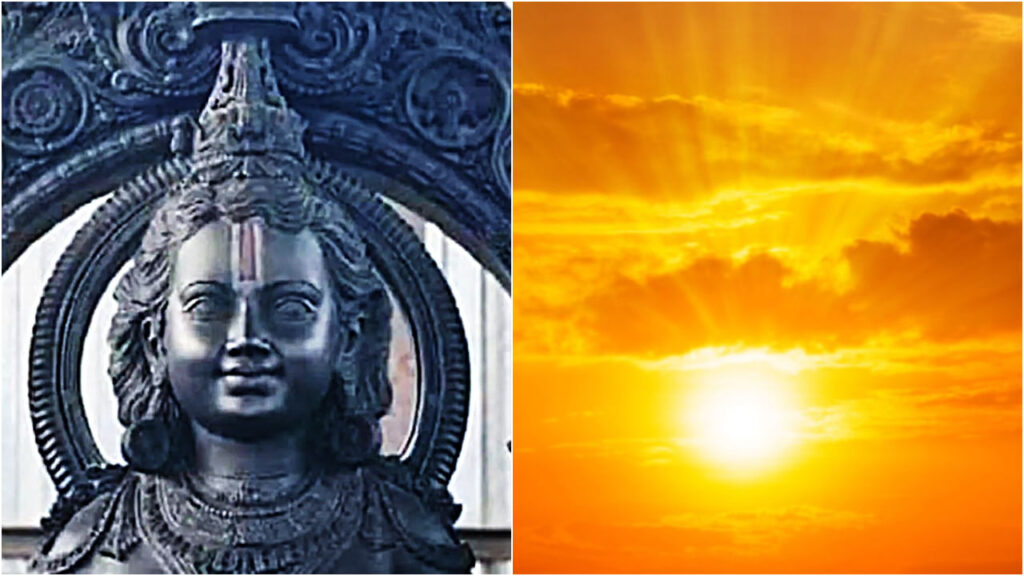News Desk, Kolkata : In the western world, there has often been a dichotomy between religion and science, but in India, these two realms have intertwined since ancient times, giving birth to both spiritual exploration and scientific discoveries. From ancient times, India has seen significant scientific advancements emerge from religious pursuits. Even in the 21st century, this tradition persists.
Before launching spacecraft into the cosmos, scientists at ISRO engage in worship at the Balaji Temple. Similarly, Indian scientists, using their knowledge, offer the “Surya Tilak” to the idol of Ram at the Ayodhya Ram Mandir. But what is this “Surya Tilak”? It’s a ritual where, on every Ram Navami, a beam of sunlight is supposed to fall directly on the idol’s forehead.
However, the completion of the temple construction is a prerequisite for this ritual to be fully realized. Dr. Pradeep Kumar Ramanchala, the director of the Rourkela-based Central Building Research Institute, mentions that once the entire temple is constructed, the process of the “Surya Tilak” will be fully functional. Currently, only the foundation up to the ground floor has been built. When the entire temple is completed, a beam of sunlight will directly fall on Lord Ram’s idol on Ram Navami for 6 minutes at 12 noon. This effect will be achieved by guiding sunlight through lenses and mirrors strategically placed on the third floor of the temple down to the sanctum sanctorum.
However, making sure this “Surya Tilak” process works correctly posed a significant challenge for scientists and engineers. The Hindu calendar determines the date of Ram Navami according to lunar positions. While Ram Navami remains fixed in the lunar calendar, the sun doesn’t stay in the same position every year. It returns to the same position after a cycle of 19 years. This misalignment between the lunar and solar calendars posed a major challenge for scientists.
To address this challenge, 19 specialized gears have been installed. These gears, without relying on electricity or batteries, automatically adjust the position of lenses and mirrors every year to align with the changing solar position. Nripendra Mishra, the chairman of the temple construction committee, reveals that initially, solar power was considered to meet the entire electricity demand of the temple, but due to the presence of “Vanar Sena” (monkey troops), solar power was abandoned as a solution.
The gears are made of brass instead of iron, and the Institute of Astrophysics in Bengaluru has designed the instruments similar to periscopes. The optical components, including lenses and mirrors, have been manufactured by an organization named Optika in Bengaluru. The entire process has received technical assistance from the Central Building Research Institute.
While the original plan aimed at utilizing solar power for the entire temple, practical considerations led to a shift in strategy. The intricacies of the “Surya Tilak” process, the involvement of lunar and solar calendars, and the adaptation of technology to seamlessly integrate with religious rituals showcase the delicate balance between tradition and scientific progress.
As the construction nears completion, the amalgamation of science and spirituality in the Ayodhya Ram Mandir stands as a testament to India’s rich heritage, where ancient traditions harmonize with modern scientific advancements, creating a unique narrative that resonates both with the divine and the technological. The journey from the ancient pursuit of religious knowledge to cutting-edge scientific solutions encapsulates the essence of India’s cultural and scientific evolution.
DISCLAIMER
Our news media denounces any form of bias and disapproves of sensationalism. The disseminated news is entirely educational and aimed at social awareness. Our media maintains absolute impartiality, adhering solely to the purpose of education and social consciousness.


